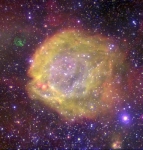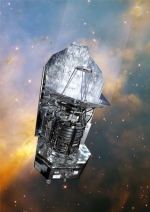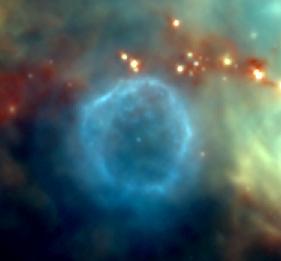- Home
- Research
- Massive Stars
- Wind Collisions
- High Energies
- Interstellar Medium
- Staff
- Outreach
- el TIGRE
Institut d'Astroph. et de Géoph.
Université de Liège
Quartier Agora
Allée du 6 août, 19c - Bât. B5c
B-4000 Liège (Sart-Tilman)
Belgium
Tel.: +32 (0)4.366.97.16
Fax: +32 (0)4.366.97.46
The interstellar medium
The space between stars is far from being void, and the matter located there is naturally called "interstellar medium" (ISM). Out of this medium comes the matter that will form stars and planets, and that is also where stellar matter will go back to, enriched in heavy elements, after it has been ejected by stellar winds, or after the death of the stars. The understanding of the star-ISM interaction and of the physical properties of the ISM is thus important towards a global knowledge of various types of galaxies. In this general frame GAPHE concentrates its activities towards the aspects particularly linked to massive stars.
Active role of the winds and of radiation
Massive stars offer two important means of acting on the ISM: their intense radiation and their powerful stellar wind.

Indeed, massive stars preferentially emit ultraviolet radiation which is capable of singly ionizing the Hydrogen and Helium contained in the ISM: this creates a type of nebulae which is called "HII regions". When the star is particularly hot, extreme UVs are emitted and, then, Helium can become totally ionized, thus creating "HeII regions". GAPHE studies these rare nebulae with the VLT, which has already lead to the discovery of an exceptionally hot star, with a surface temperature higher than 120000°C.
Besides the chemical enrichment of the ISM, a stellar wind also plays a mechanical role: it "pushes" the surrounding medium. This produces expanding gaz bubbles, which are observable over the entire electromagnetic spectrum. GAPHE has studied several of these "bubbles", which has lead to a "revisit" of the existing models! GAPHE has also been involved in a number of projects aiming at the X-ray study of the interaction between clusters of massive stars and the ISM.
Mass ejection


Between their birth and their death, massive stars do loose a lot of matter, sometime even more than 50% of their mass! Such a mass loss does take place through stellar winds, but not only, since it cannot eliminate 10, 20, 30 solar masses. In fact, during its life, a massive star goes through an unstable evolutionary stage, e.g. that of "Luminous Blue Variable" (LBV). During this latter phase, the star goes through violent eruptions/outbursts that eject surface material. This phase happens to be extremely important in order to understand the star's evolution as well as the enrichment of the ISM; however, and unfortunately, because of its short duration and its intrinsic instability, it is seldom observed. Only a dozen of LBVs are known in our Galaxy. Such objects must therefore be thoroughly studied, and not only the star itself, but also the traces of the past eruptions that can be found as ejected nebulae. Due to the Belgian participation (and that of Liège in particular) to the Herschel ESA mission (telescope tests, construction of the PACS instrument) GAPHE obtained a privileged access to guaranteed time. These far infrared observations bring unique pieces of information concerning most of the galactic LBV nebulae.They notably showed that the nebulae are ejected at different stages in the life of the star, depending on its initial mass.



